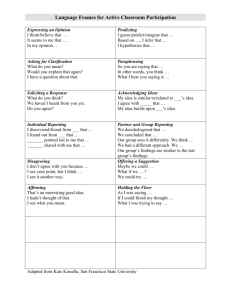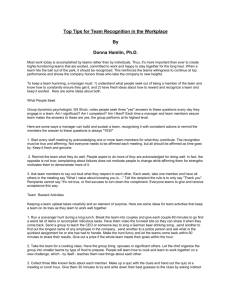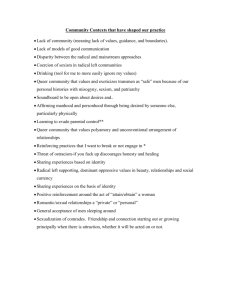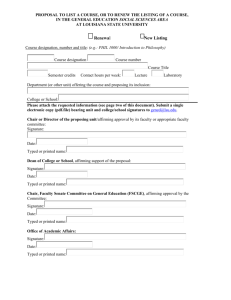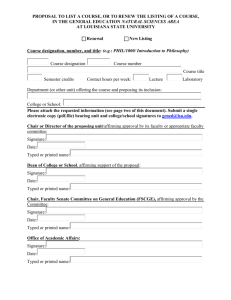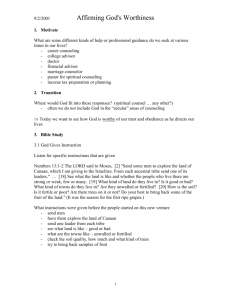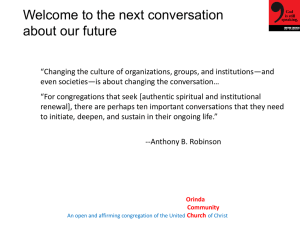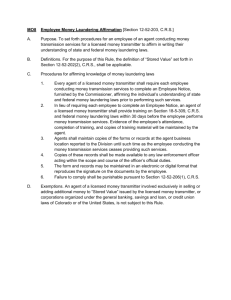The Affirming Leader - University of Memphis Blogs
advertisement
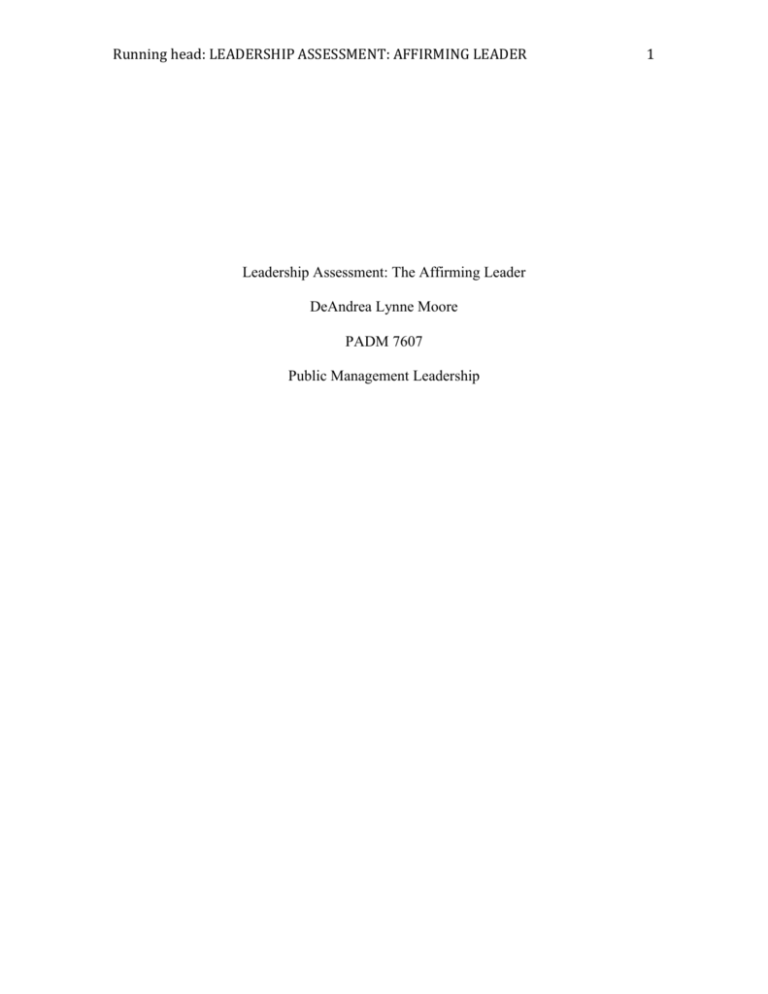
Running head: LEADERSHIP ASSESSMENT: AFFIRMING LEADER Leadership Assessment: The Affirming Leader DeAndrea Lynne Moore PADM 7607 Public Management Leadership 1 2 LEADERSHIP ASSESSMENT: THE AFFIRMING LEADER “Before you are a leader, success is all about growing yourself. When you become a leader, success is all about growing others – Jack Welch.“ Leadership is an attribute that many professionals seek to obtain through education, career experience, and professional development workshops. Leadership is not based on the achievement of a position within a hierarchy system; it is based on the effectiveness to lead others within an organization. Effective leaders recognize their strengths and weaknesses, utilizing both characteristics to accomplish the mission and goals of an organization, as well as implement change. Leadership is complex, involving an array of assessment skills and a series of characteristics that the leader brings to a particular setting (Van Wart, 2011. p.3). Therefore, it is important to evaluate one’s personal leadership style and discover the necessary tactics to navigate through effective leadership within any organization. In the book entitled, the 8 Dimensions of Leadership, the authors identify eight categories in which a person can discover his/her leadership style by taking an online assessment based on various interpersonal scenarios. The responses received from the situation analysis are used to determine one’s leadership style and development within an organization. The eight leadership styles are Affirming, Inclusive, Humble, Pioneering, Commanding, Deliberate, Resolute and Energizing. The eight categories identify various characteristics for each type of leadership style and common behaviors associated with leading an organization. The book serves as a foundational tool to identify one’s leadership style, strengths and weaknesses; thereby, assisting in one’s ability to become a more effective leader. Moore 2 3 LEADERSHIP ASSESSMENT: THE AFFIRMING LEADER The Affirming Leader In the Disc Assessment, I was identified as an Affirming leader. The Affirming leader desires to create a sense of family within an organization. This type of leader obtains the attributes of Maslow’s theory of need, which is providing a sense of belongingness, family, and team-like culture within an organization. In turn, creating the framework for employees to embody the vision of the core mission and values of the program (Bolman & Deal, 2008). The Affirming leader desires to inspire people around him/her to succeed, engage in open communication, and creates a positive atmosphere through collaborative efforts. These efforts provide each employee with the perception of being on a team and contributing a significant role to the growth of the organization. The job of this leader is one of support and empowerment. Support takes a variety of forms: letting people know they are important and that managers are concerned about them; listening to find out about their followers’ aspirations and goals; and, communicating personal warmth and openness (Jacobs, Bolman and Deal, 1991, p. 359). Creating a personal connection with each employee is imperative to this leadership style. The Affirming leader is strong in building lasting relationships and celebrating the successes of the team. This leadership style is not self-indulged nor ego “happy”, but utilizes inclusive steps to include the team in decision-making. As a result, relationships are important to this leader, as well as being accepted by others. This leader seeks to bring warmth to an organization, positive outlooks and cohesion among managers and employees. The Affirming leader also understands the trials of life and is patient with other members on the team. Moore 3 4 LEADERSHIP ASSESSMENT: THE AFFIRMING LEADER Optimism is one of the strengths of the affirming leader, in addition to possessing the ability to be open-minded to other’s perspectives and/or opinions. This leader recognizes that people are the heartbeat of the organization and that they should have the autonomy and resources to do their jobs well (Bolman & Deal, 2008). An affirming leader is a catalyst and facilitator who motivates subordinates by utilizing their listening skills to create an atmosphere of two-way communication in order to gain commitment and loyalty (Jacobs, Bolman & Deal, 1991, p. 359). The affirming leader is also flawed and weaknesses should be addressed to be more effective within an organization. Weaknesses: The Affirming Leader As the Affirming leader is proficient in creating a positive atmosphere within workplace relationships, the framework that this leader uses to address structure, strategy and implementation can portray this leader to be ineffective. As a result of this interest in personality and emotions, the affirming leader lacks the structural framework of clarifying the lines of authority and focusing on the tasks, facts, and outcomes of their employees (Bolman & Deal, 2008). This leader is not driven by quantitative or qualitative results, such as employee evaluations or customer satisfaction surveys, but by establishing interpersonal relationships. The affirming leadership style can be ineffective in communicating expectations or deadlines for the department or organization. This weakness allows subordinates to abuse the autonomy given by the affirming leader and takes advantage of the empathy given from affirming leaders. In addition their limitations, the affirming leader is less likely to be direct with others and address any mistakes or critical observations on levels of performance. Moreover, affirming leaders Moore 4 5 LEADERSHIP ASSESSMENT: THE AFFIRMING LEADER are typically naïve and provide people with “face-value” trust, without identifying dishonest or manipulative patterns. These flexible and open leaders are deliberate in communicating with others and lack the effectiveness to convey expectations to them without accepting excuses. The affirming leader desires to belong and be accepted within the organization, and is less likely to handle conflict. Furthermore, these leaders are also less likely to challenge the ideas of others or provide strong feedback, when necessary (Scullard, Sugerman & Wilhelm, 2011). The affirming leader’s demeanor is so positive and optimistic that confronting challenges within the workplace is a difficult task for some. For example, the leader will turn down an opportunity to learn a new skill, sit on a challenging legislative board, or disagree with the structure of a program/task, in order to be harmonious and avoid conflict with anyone. The affirming leader has strong desires to be accepted and connected to others, in order to gain a “team-like” atmosphere. When affirming leaders are disconnected from an organization and lacking personal fulfillment, it is difficult for them to be effective in an organization. Lastly, the affirming leader avoids complex analysis or situations. The affirming leader is satisfied with just enough, not festering over the issues, the complex diagram and making tough decisions that may affect others, especially their means of financial stability. The affirming leader is geared towards emotions, relationships, peace and a sense of cohesiveness with others. Moore 5 6 LEADERSHIP ASSESSMENT: THE AFFIRMING LEADER Affirming Leader and Career Goals The Affirming leader has been described as warm and compassionate towards others and a people person, which relates to my career goals. My career aspirations include interests in local government, public health, and healthcare policies. I have interests in interagency collaborations between hospitals, education institutions, and government programs focusing on positive outcomes within the community. My current focus is on the federally funded Affordable Health Care Act and the effects of its implementation on the healthcare of Tennesseans, healthcare policy and patient care. Specifically, the positions that I would like to reach in my career path are Government Relations Coordinator, Public Health Coordinator, Community Healthcare Program Director, and Director of School Coordinating Healthcare. My ultimate career goal is to become the Vice President of Government, Advocacy and External Relations within a hospital or medical educational institution. I aim to assist in the access and improvement of healthcare within the United States, healthcare policies and the overall health of Americans. These career goals may seem challenging, but striving for it will be a continuous effort. When looking at my career aspirations and the wide spectrum of positions in which I would like to achieve, helping others is the foundation of my compassion for: Creating a harmonious atmosphere with various organizations to improve the health of Americans. As an affirming leader I have the characteristics to increase company morale, provide a family-like culture, praise the successes of others and the team, as well as, maintain open communication, and balance of being authoritative and sensitive. Although Moore 6 7 LEADERSHIP ASSESSMENT: THE AFFIRMING LEADER I am compassionate and optimistic in my leadership approach, and my ability to empower others; I have the tendency to provide too much autonomy among subordinates. This opens me to be viewed as a pushover in certain situations. It is imperative that affirming leaders embrace their strong attributes, to create an atmosphere in which an organization can provide a holistic culture for employees. The affirming leader must address the weaknesses that could hinder the growth, mission and goals of the organization. Affirming leaders must be able to balance their desire to build lasting relationships and the acceptance of others, to be results driven, focused, direct, and open to challenges to ultimately reach the overall outcomes of the organization. Leadership Weakness Development The Disc assessment associated with the book, 8 Dimensions of Leadership, outlined several weaknesses of the affirming leader. The weakness I identify with the most is aversion to conflict. This weakness occurs when conflicts arise and the affirming leader takes an indirect path or position. The affirming leader is also less likely to provide tough feedback even when it is needed. The affirming leader is diplomatic in most situations and tries to stay away from tough situations that involve conflict and/or disagreements. In addition, these leaders tend to take on responsibility when they are involved or indirectly involved in a conflict, as well as being a peacemaker in some situations. This leadership weakness is one I have become aware of since starting this course. At first glance, I did not recognize this trait as a weakness. As I assessed the characteristics and discovered literature regarding conflicts, I accepted the truth within myself: I do avoid conflict situations. Most recently at my job, I found myself not Moore 7 8 LEADERSHIP ASSESSMENT: THE AFFIRMING LEADER wanting to confront a situation in which I was involved. I tried to be a peacemaker and not stand up for myself. The workplace situation occurred based on an email that was sent to several key stakeholders, in which I was accused of not following proper protocol (when in fact I did). However, the person sending the email did not properly check the facts. Instead of instantly replying back in an email to this higher-ranking employee, I tried to ignore the accusation and let the proof be shown in the end. Nevertheless, my supervisor encouraged me to send an email, copying the same stakeholders the accuser had copied. I outlined the steps I took with this project and stated profusely that the accusations were inaccurate. After sending the email, I felt dispirited about the actions taken. The following day, I received an email from this person with an apology expressing sincere regret for not checking the facts first. After conflict within this organization, I finally understood my leadership style and the weakness that I thought was irrelevant. I always saw myself as direct, ready to deal with any situation, an over-comer and fighter regarding workplace issues. Realizing this weakness was very prevalent in my acceptance of this leadership style and realizing how it can impact my abilities within my future career. As a public administrator, it is imperative to obtain the necessary skills to deal with conflict within any organization. It is essential that an administrator recognize the nature of conflict for what it is (Derr, 1972). To assist my skills in dealing with conflicts, I obtained a book entitled, Dealing with Conflict and Confrontation. This book teaches professionals and mangers how to keep cool, stand their ground, and reach a positive solution in conflicting situations. The book outlined the various reasons why conflict is not always a negative situation and can yield positive results, such as “producing change Moore 8 9 LEADERSHIP ASSESSMENT: THE AFFIRMING LEADER for the better, new innovations, new ideas, and bringing positive behavioral changes within an organization (Rhodes, 2006, p. 5).” The book outlined several strategies on how managers should deal with conflict. To properly handle conflict, it is necessary to analyze the situation and decide if it is a conflict or disagreement. Disagreements are opinions about facts, interpretations of reality, and accusations of misconduct. Conflict is a perceived divergence of interests, or a belief that the parties’ current aspirations or goals cannot be achieved simultaneously (Rhodes, 2005). The book further outlines primary reasons for conflicts and whether someone holds an interest or position within the conflict. A position is what a person wants and an interest is why you want it –your motivation behind it. When dealing with conflict, one must be able to separate personal feelings or wants, for the betterment of the organization, as well as speaking up for what is morally right (Rhodes, 2006). To handle conflict within an organization and improve the weakness of the affirming leader, it is important to utilize conflict-resolution strategies. Conflict – resolution strategies assist the affirming leader in overcoming weaknesses and communicating thoughts in adverse situations. To best address weakness, an affirming leader should consider utilizing skills in bringing people together and creating a dual concern model, which is a theoretical approach in evaluating multiple interest of others, such as employees, colleagues, subordinates, organization meetings or situations that he or she is involved. The dual concern model provides the best chance for improved relationships within an organization (Rhodes, 2005). The dual concern model is an open communication approach of coming to an agreement in which all parties will be satisfied; therefore, creating an atmosphere of cooperation and resolution. Some strategies an Moore 9 10 LEADERSHIP ASSESSMENT: THE AFFIRMING LEADER affirming leader can use to resolve conflicts within an organization are yielding, withdrawing, inaction, contending, and problem solving. The type of strategy that one can use is dependent on his attitude towards meeting one’s own goal or being concerned about other people meeting their goal. The strategies outline several outcomes: yielding is giving in to the other person; withdrawing is the abandonment of conflict, physically or psychologically; inaction is a unilateral approach from a non-coping strategy arising from procrastination or denial; contending is forcing others to give into an attitude that only you can/must win; and problem solving is combining the concerns of both parties with resolution tactics to reach an agreeable outcome (Rhodes, 2006, p. 8 -30). The five strategies that the book outlined are dependent on the importance of meeting one’s own goal, another other’s goal, or coming to a common ground to meet the expectations of the organization. The best way for an affirming leader to handle conflict within an organization is using the strategy of problem solving. The problem solving strategy involves applying four preconditions in order to be successful; “A concern for mutual gain, flexible solutions and firmness on interests, creativity and separate people and the problem (Rhodes, 2006).” When these preconditioned steps are taken, the affirming leader can then determine if the situation is a disagreement or true conflict. If it is a true conflict, it is important for the affirming leader to analyze the interests of both parties, outline those goals, discuss the problem, and look for possible solutions that can satisfy all participants. When these conflict-resolution steps are used within a situation, the organization and the parties involved will benefit in efficiency, maintaining or improving workplace relationships and the opportunity to work together to reach agreements in the future (Rhodes, 2006). Moore 10 11 LEADERSHIP ASSESSMENT: THE AFFIRMING LEADER The role of a leader is to empower and support subordinates, create a team atmosphere, provide autonomy and resources to achieve the organization’s goal successfully, and develop two-way communication to manage conflict as productively as possible. Above all, an effective leader needs to use his power carefully. Leaders cannot give every group within the organization everything it desires, although leaders can try to create arenas for negotiating differences and developing reasonable compromises (Jacobs, Bolman & Deal, 1997, p. 361). In conclusion, the affirming leadership style has helped me identify the type of leadership skills and traits I possess, as well as, those weaknesses in which I should strive to improve. I believed the Disc assessment was accurate in its description of my leadership style. I am a leader that enjoys making others feel a part of a team, encouraging others, building a sense of connection with others and having open communication with my colleagues. Furthermore, I enjoy seeing my team members come up with great ideas, being spotlighted for their achievement, as well as understanding the ups and downs of their lives. In spite of these strong traits, I convey leadership weaknesses in which I can be perceived as a pushover, too understanding, and not firm in my abilities to be an efficient leader. Lastly, it is difficult for an affirming leader to give tough feedback to subordinates, fight for personal ideas among colleagues, and confidently address conflict within an organization. The weaknesses of being an affirming leader can hinder my ability to be an effective leader, set goals, and hold employees accountable to attain the goals of the department or organization. It is imperative to identify the characteristics of the affirming leadership style and utilize journal articles, workshops, and leadership Moore 11 12 LEADERSHIP ASSESSMENT: THE AFFIRMING LEADER development conferences to assist in my success and development as an effective leader. I strive to be a leader who is not only personable, fair, and understanding, but a leader who is reliable in my leadership abilities to get the job done, provide feedback, and results driven in achieving the mission and goals of the organization. Moore 12 13 LEADERSHIP ASSESSMENT: THE AFFIRMING LEADER References Bolman, L. G., & Deal, T. E. (1991). Reframing organizations: Artistry, choice and leadership (2nd ed.). San Francisco: Jossey-Bass. Bolman, L. G. & Deal, T. E. (2008). Reframing organizations: Artistry, choice and leadership (4th ed.). San Francisco: Jossey-Bass. Derr, B., (1972) Conflict resolutions in organizations: Views from the field of educational administration. Public Administration Review, v32, 495-501. Jacobs, R. M. Theories of practice: The human resources frame (PDF document). Retrieved from www83.homepage.villanova.edu/richard.jacobs/.../human.pp Scullard, M., Sugerman, J., & Wilhem, E. (2011) The eight dimensions of leadership: Disc strategies for becoming a better leader. San Francisco: Berrett Koehler Publishers. Rhodes, H. (2005) Dealing with conflict and confrontation: How to keep your cool, stand your ground, and reach a positive solution. Park University Enterprises. Moore 13
